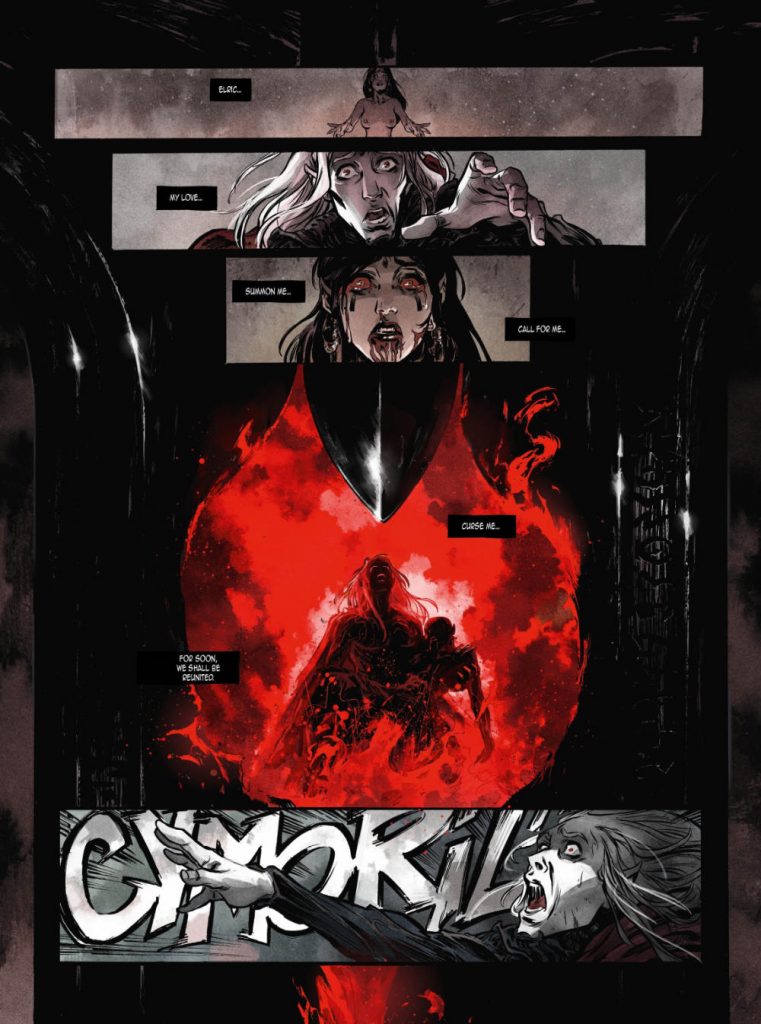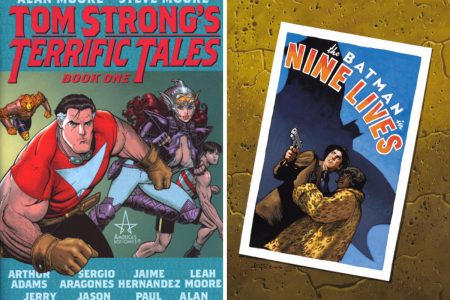Elric created by Michael Moorcock
Written by Julien Blondel & Jean-Luc Cano (based on the novel by Michael Moorcock)
Art by Julien Telo, Robin Recht, Didier Poli
Colours by Robin Recht, Jean Bastide & Scarlett Smulkowski
Translated by Edward Gauvin
Letters by Gabriela Houston
Published by Titan Comics
I always feel in adequate in my geek qualifications when I admit that I haven’t read much Moorcock; I’ve read more by authors who have named him as a specific influence (Grant Morrison, Warren Ellis and Alan Moore, who provides an excellent foreword to this book). I don’t know if it’s an issue of timing – if I’d been born 10 years earlier, perhaps, or discovered collected editions in the library when I was a teen, I might have been a convert to the church of Moorcock. However, I am aware of his stature in the field and the fondness and respect with which the stories of Elric of Melniboné are held by people better read than me, which is why I was eager to try this book.
This 64-page hardcover continues with the adaptation of the Elric novels, and is the second in the series so far. The book provides enough context in two paragraphs to bring the reader up to speed (although, in contrast to my opening paragraph, I have actually read this previously in prose form, so I was aware of the story so far anyway). Elric is the emperor of ancient Melniboné, an albino with pink eyes, ruling from the ruby throne in Imrryr, the dreaming city. However, his rule is threatened by his traitorous cousin, Yyrkoon, who has kidnapped Elric’s queen, Cymoril. Angry and desperate, Elric has called upon Arioch, the Lord of Chaos, to aid him in his quest to find Cymoril and punish Yyrkoon. But calling on a Lord of Chaos, by definition, will not go smoothly …
This instalment of the saga sees Elric make his bargain with Arioch; enlist the aid of Straasha, king of the seas; journey on the Ship Which Sails Over Land And Sea; have an encounter with Grome, king of the earth; fight Yyrkoon; and realise the nature of his fate is entwined with the dark sword, Stormbringer. It is easy to see why Moorcock is revered as an author of fantasy and science fiction – this story is the stuff of legends but told in a fresh and invigorating fashion, and his ‘fate-harrowed icon’ (a delightful turn of phrase from Moore in the foreword) is a rich and fascinating tragic figure. The wonderful names (Dyvim Tvar, Vaarda’sh, Dhoz-Kam), the playing with mythology, the broad tapestry filled with details – there is a reason why these stories have been adapted repeatedly in comic books and why they resonate with readers.
 Another interesting aspect is described by Moore (he’s a smart chap – he’ll go far) when he talks about how we the readers change but Elric does not – the character remains the same but the way we see him does not. I can easily imagine how this story would captivate a teenage version of me, with the angst and the torment and the sacrifice perfectly encapsulating my adolescent mindset. As a man who is older, if not wiser, I see sadness and giving into fate and love blindness that interfere with duty, and I can even see an all-consuming selfishness that causes me to despair a little. In a way, this interpretation by a French creative team seems to capture all of that at the same time, as if it is in sync with the Gallic temperament (as least as I understand it from watching French movies) – the belief in love conquering all yet the inevitable betrayal for reasons that seem noble somehow resonates more keenly through a French perspective.
Another interesting aspect is described by Moore (he’s a smart chap – he’ll go far) when he talks about how we the readers change but Elric does not – the character remains the same but the way we see him does not. I can easily imagine how this story would captivate a teenage version of me, with the angst and the torment and the sacrifice perfectly encapsulating my adolescent mindset. As a man who is older, if not wiser, I see sadness and giving into fate and love blindness that interfere with duty, and I can even see an all-consuming selfishness that causes me to despair a little. In a way, this interpretation by a French creative team seems to capture all of that at the same time, as if it is in sync with the Gallic temperament (as least as I understand it from watching French movies) – the belief in love conquering all yet the inevitable betrayal for reasons that seem noble somehow resonates more keenly through a French perspective.
This richness of interpretation also continues through to the art – it is dark and angry yet beautiful and tragic, mixing light and shadow to tell the story, contrasting the colour of Elric’s skin and eyes with the palette of black and reds that dominate. Elric is a powerful figure, powerful yet haunted, philosophical yet a force of nature. If a reinterpretation of the eternal champion in comic-book form is done, then the art must be something worthwhile or it is an exercise in futility, but the art here is definitely worth the adaptation. If anything, it makes me want for more than the 64 pages of story here – I know it is the way of bande dessinée to have these smaller volumes coming out more regularly, but it’s not enough for someone like me used to trade paperbacks of double the size. Moorcock has declared this as his favourite Elric adaptation thus far, Alan Moore agrees with him; I’m not foolish enough to disagree with them. Bring on the next volume.
Disclosure: this book was provided for review purposes.




